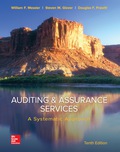
Concept Introduction:
Codes of professional conducts include a list of principles and regulations which define the set of standards of ethic and professional behavior that require for each members of the entity. It gives the general outline for the institute and its members, how they should behave and perform.
To describe: Three theories of ethical behavior that can be used to analyze the ethical issues in accounting
Explanation of Solution
The ethical behavior includes the general outline for the institute and its members, that how they should behave and perform. The theories of ethical behavior are described below:
Utilitarianism: Utilitarianism is an ethical theory that determines the rights things from the wrong one, and indicates that the most ethical decision is one which produces the greatest happiness. In accounting, utilitarianism theory helps to determine both the right and wrong side of a particular action, and focus on the result of the action.
Right-based approach: A right-based approach include that individual should aware of their rights and, he should participate in the government and development policies. It helps them to live their life as they want to live and can claim for their right when needed. So if any decision-maker accepts the theory of right then, he should give respect to each individual’s right.
Justice-based approach: The justice-based approach includes the justices for each individual and makes them confident that everyone can use and better achieve their goals. This approach is used for the better development for the society. This approach assumes that each individual has needs equality while decisions made for them.
Want to see more full solutions like this?
Chapter 19 Solutions
EBK AUDITING & ASSURANCE SERVICES: A SY
- Mr dev.arrow_forwardWhich of the following is not true about goodwill?* Goodwill needs to be evaluated for impairment yearly Goodwill is treated as a tangible asset in accounting Goodwill is a result of purchasing a company for a price higher than the fair market value of the target company's net assets Goodwill can be comprised of things such as good reputation, loyal client base, and brand recognitionarrow_forwardWhat is working capital?* Equity Capital + Retained Earnings Equity Capital - Total Liabilities Total Assets - Total Liabilities Current Assets - Current Liabilitiesarrow_forward
- Which of the following is not a financing activity?* Repayment of long-term debt Issuance of equity Investments in businesses Payment of dividendsarrow_forwardThe correct order of capital stack from the most to least secured is* Equity > Subordinated debt > Senior debt Suborindated debt > Senior debt > Equity Senior debt > Subordinated debt > Equity Senior debt > Equity > Subordinated debtarrow_forward16. ____ underwriting commitment is when the underwriter agrees to buy the entire issue and assume full financial responsibility for any unsold shares.* Best efforts Firm commitment All-or-none Full-purchasearrow_forward
- Which of the following is not true about private equity funds?* Private equity funds are pools of capital invested in companies which represent an opportunity for high rate of return Exit strategies for private equity funds include Initial Public Offerings (IPOs) and leveraged buyout (LBO) Venture capital is an example of private equity funds Private equity funds are usually invested for unlimited time periodsarrow_forwardWhat is finance ? explain about its parts.arrow_forwardDividend problem . Solve plzarrow_forward
- Business/Professional Ethics Directors/Executives...AccountingISBN:9781337485913Author:BROOKSPublisher:Cengage
 Intermediate Accounting: Reporting And AnalysisAccountingISBN:9781337788281Author:James M. Wahlen, Jefferson P. Jones, Donald PagachPublisher:Cengage Learning
Intermediate Accounting: Reporting And AnalysisAccountingISBN:9781337788281Author:James M. Wahlen, Jefferson P. Jones, Donald PagachPublisher:Cengage Learning Auditing: A Risk Based-Approach (MindTap Course L...AccountingISBN:9781337619455Author:Karla M Johnstone, Audrey A. Gramling, Larry E. RittenbergPublisher:Cengage Learning
Auditing: A Risk Based-Approach (MindTap Course L...AccountingISBN:9781337619455Author:Karla M Johnstone, Audrey A. Gramling, Larry E. RittenbergPublisher:Cengage Learning


